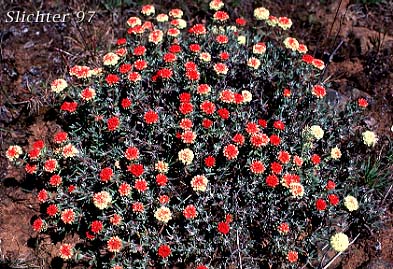 The photo at right shows a close-up of the inflorescence of scabland wild buckwheat as seen at a DNR rockpit at an elevation of 4100 ' at the end of Rd 6900 on the east side of Mt. Adams.........May 29, 2005.
The photo at right shows a close-up of the inflorescence of scabland wild buckwheat as seen at a DNR rockpit at an elevation of 4100 ' at the end of Rd 6900 on the east side of Mt. Adams.........May 29, 2005.
Scabland wild buckwheat is a low, matted shrublet, from 5-10 cm tall, and sometimes several feet in diameter. The leaves are mostly linear to linear-spatulate in shape, often gray or whitish haired on both surfaces. They range from 5-20 cm long and 1.5-3 mm wide. A whorl of linear leaves may be found at about mid stem on the flower stems. No stem leaves or bracts are found directly below the flower heads.
The inflorescence is a single rounded, thumb-sized head or clump, about 13 mm across. They are a whitish-yellow color, sometimes bright lemon-yellow, or may be tinged with pink or red. The pink or red may especially be seen in the unopened flower buds (see photo below). The individual flowers are sparsely to moderately haired on the outer surface. The involucres are shallowly conical to bell-shaped with 6-10 spreading to reflexed lobes about 1.5-5 mm long, or about equal in length to the tube. .
E. douglasii var. douglasii: Perianth strongly hairy, especially towards the base. Found to the east of variety tenue, from central Washington south through central and eastern Oregon to northern California and the Sierra Nevada and east to western Idaho and Nevada.
E. sphaerocephalum var. sublineare: Perianth sparsely hairy to occasionally glabrous or weakly glabrous. Found along the eastern base of the Cascade Mts. from southern Yakima County in Washington south to Wasco County in Oregon.
Scabland wild buckwheat is found on dry, rock, open flats and slopes often associated with sagebrush, sometimes with juniper and ponderosa pine.
Scabland wild buckwheat may be found from central Washington south to the eastern slopes of the Sierra Nevada, and eastward to western Idaho and Nevada.
